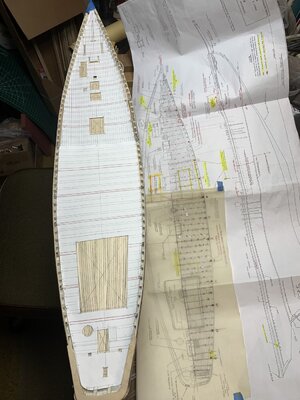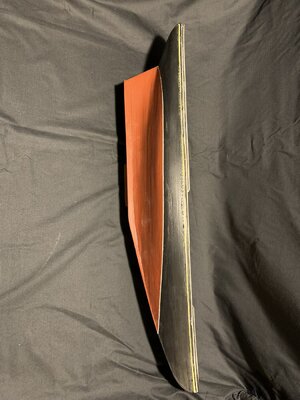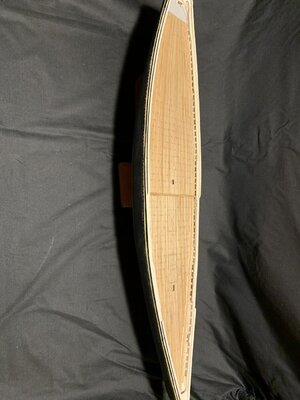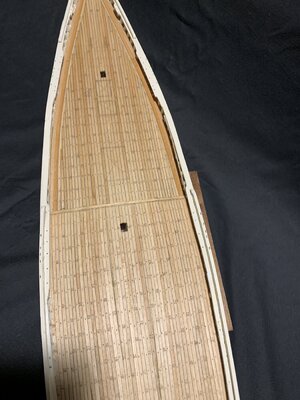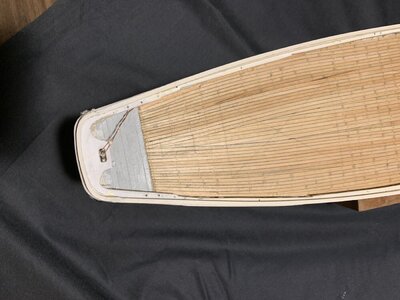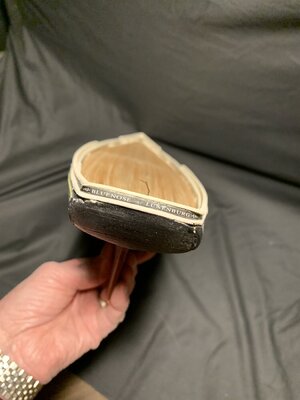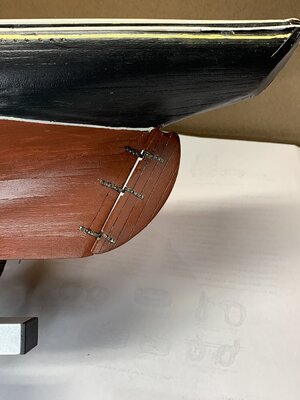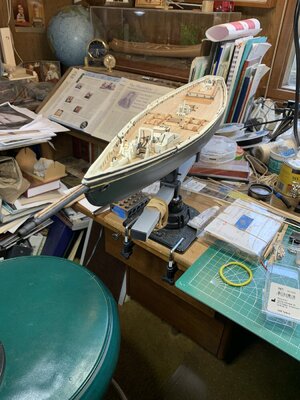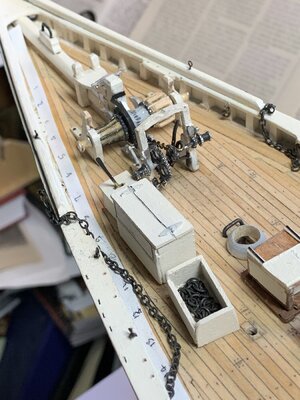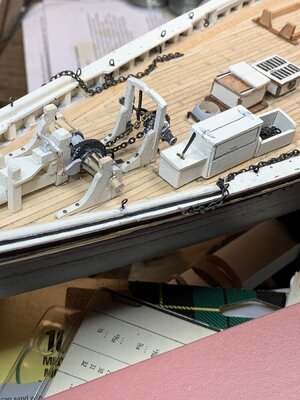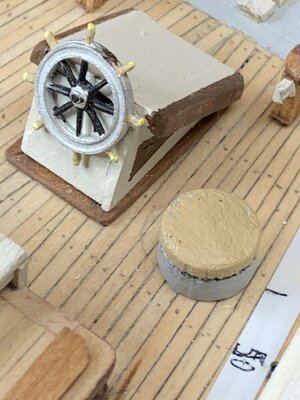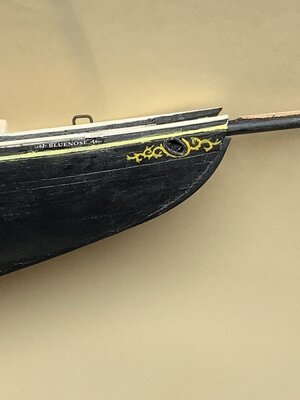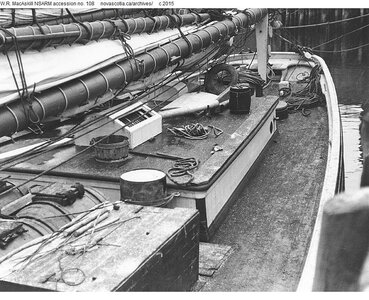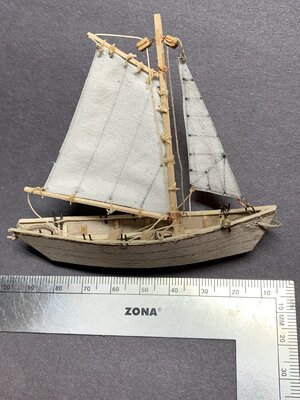I need your experience and recommendation on how to coordinate the main rail and monkey board on top along with the monkey rail as to installing those three with the slots for chain plates and longer eyebolts through all to the deck aligned. I have been mentally working round this problem for days. I did fabricate the main rail in five sections between the transom main rail and bow rail laser cut pieces as recommended in two different instructions but not really talked about t all in the MS2130 instructions. My main rail scarf joints are not all tight but as they are painted I will apply some filler, sand smooth, and paint over once they are glued down. That starts the alignment of the holes issue. Please share your experience as I need that to add to me own ideas to avoid an additional compounding problem in getting these rails installed to move forward. Thanks, Rich (PT-2)
Hi Rich, The rail installation can be very frustrating, or relatively easy, as was in my case. I will explain exactly what I did, and perhaps that will help. I purchased matte board ( for framing pictures). It has about the same stiffness as the bass wood we are using, and it can also be used as a building board when done. I traced the outline of the hull on the matte board, and added 2mm to the tracing to simulate the main rail overlap of the hull. I then traced the main rail dimensions onto the matte board, and used that as a template for main rail fabrication. I remade the transom main rail (the kit supplied part is unusable), then port and starboard rails from a single piece of basswood. I then scarfed and glued the new transom main rail, the port and starboard rails, and the kit supplied bow main rail together into one single piece. I trial fit this piece to the ship, and sanded where required ( the 2mm overlap was sufficient for minor variations).
This single main rail piece was masked where it contacted the stanchions and top most plank on the B.N., and also topside where the monkey board would be glued. I added the buffalo rail, and then spray painted top and bottom in white..be sure to fill and sand before masking. I use Tamiya tape, or cut narrow strips of yellow frog tape for masking. Both work very well.
I then formed the monkey board. I soaked the board in hot water for ten minutes, and using the matte board, I pinned and slowly shaped the board, the dried it with my heat gun. Then I masked the top and bottom edges, and spray painted black. I always lightly sand every piece of basswood before using it. Its a good habit to get into.
The monkey board is now glued onto the main rail. The monkey rail was also fabricated from a single piece of basswood sheet, sanded, masked where it meets the monkey board, and spray painted white. It was then glued onto the monkey rail. We now have a painted and finished ONE PIECE main rail with all its accoutrements.
Be sure to have a solid cradle for the next part. I trial fit the main rail to the B.L., added several pin holes through the main rail into stanchions, three on each side. These predrilled pin holes would serve to position the main rail accurately once I was ready to glue. I then removed the masking tape under the main rail, and applied PVA to the mating surfaces, carefully positioning the main rail with pins through my predrilled holes, and added lots of weights to the rail. I used short lengths of 2x4's which when placed across the main rail kept it perfectly horizontal to the deck, then weights on top of those. When the glue set, voila. a job well done, and painted to boot.
Its a simple matter of marking the main rail paraphernalia once it is on the ship. Hope that helps.
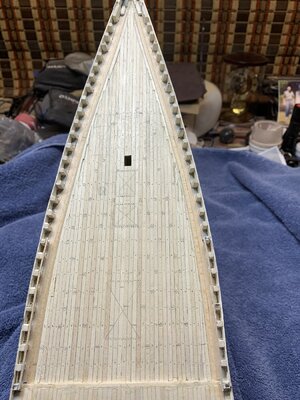
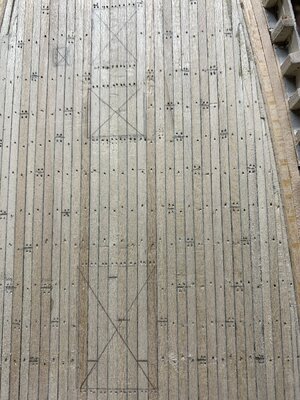 and the alternating up of down single fastener into the beam below, using a sharp awl and .3 mm pencil for darkening the depression. It shocked me how this "change of visual scale" took on a cluttered appearance from the former smooth caulked decking lines. I am now doing the same on the after deck which is a greater challenge as the planks narrow/taper down I width as they curve around approaching the transom. I'm almost chicken to post any photos of that but will anyway. . . . holding my breath for what the reaction may be. It is not the typical very uniform decking/fastening that I have seen elsewhere I SoS builds or any of the Bluenose model submissions. Not up to Ohla's standards but what my hands and vision produce.
and the alternating up of down single fastener into the beam below, using a sharp awl and .3 mm pencil for darkening the depression. It shocked me how this "change of visual scale" took on a cluttered appearance from the former smooth caulked decking lines. I am now doing the same on the after deck which is a greater challenge as the planks narrow/taper down I width as they curve around approaching the transom. I'm almost chicken to post any photos of that but will anyway. . . . holding my breath for what the reaction may be. It is not the typical very uniform decking/fastening that I have seen elsewhere I SoS builds or any of the Bluenose model submissions. Not up to Ohla's standards but what my hands and vision produce.


